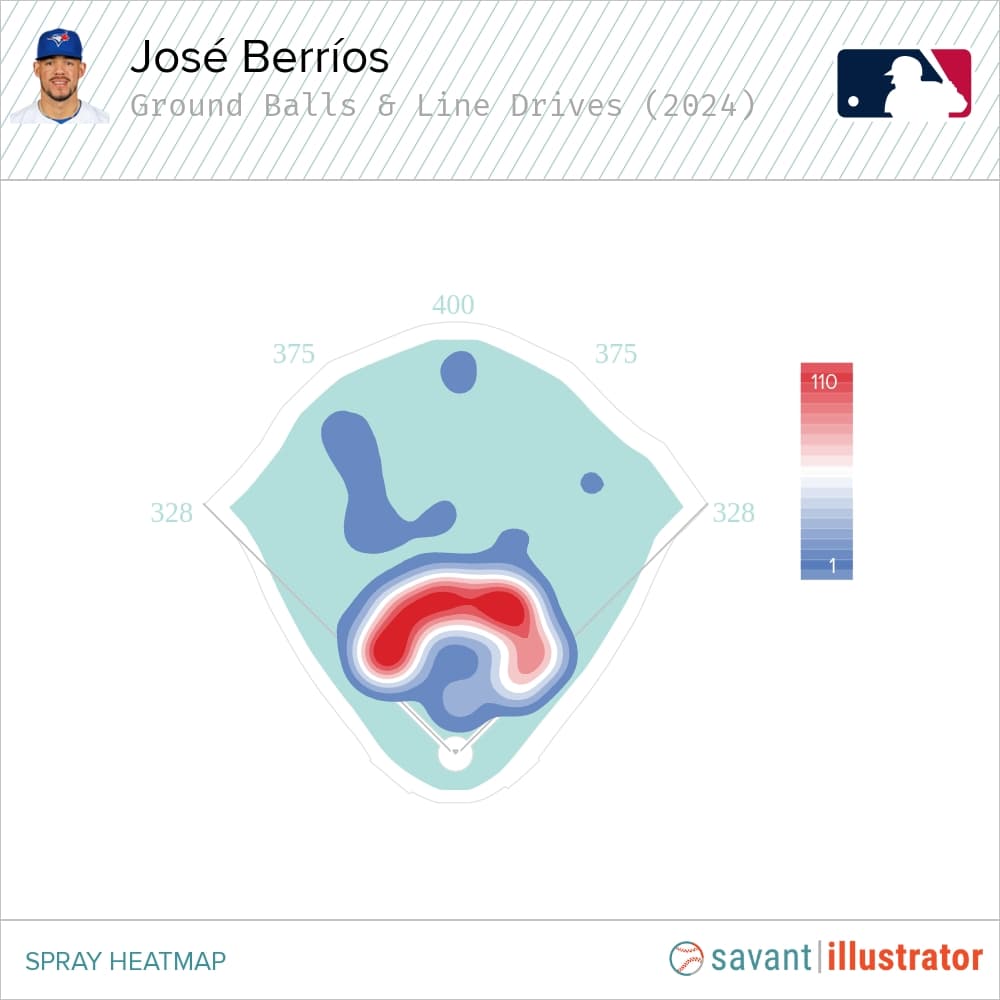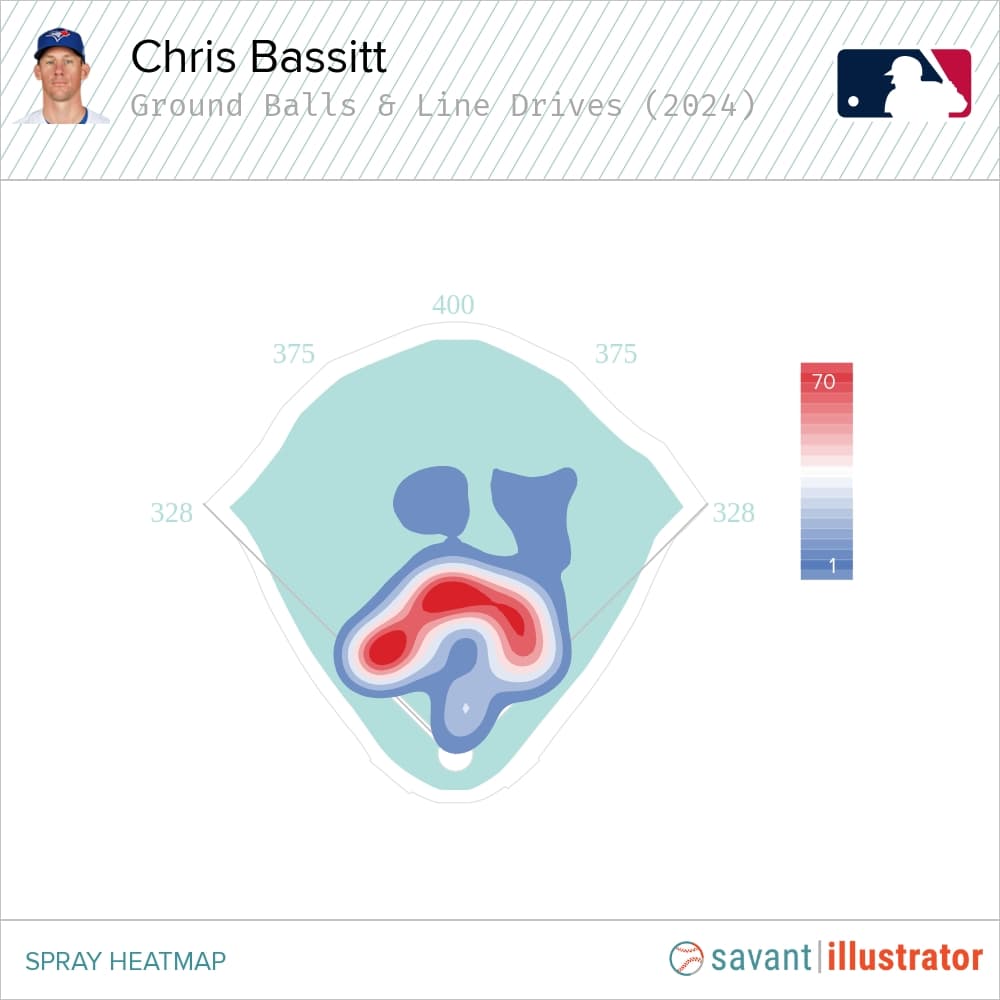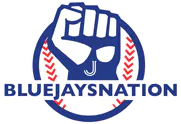How much third base should Vladimir Guerrero Jr. play next season?

Photo credit: John E. Sokolowski-Imagn Images
By Thomas Hall
Sep 24, 2024, 15:00 EDTUpdated: Sep 24, 2024, 16:55 EDT
Beyond a contract extension, Vladimir Guerrero Jr.’s position figures to be among the biggest off-season questions for the Toronto Blue Jays, who’ll face several critical decisions in the coming months.
We already know Guerrero’s stance on the matter. Third base is still his position, as he reiterated to Sportsnet’s Shi Davidi in Tampa Bay last week. But, at the same time, the four-time All-Star added he’s willing to do what’s best for the team — whether that’s playing first or third.
If that means blowing past the 100 innings he’s logged at the hot corner this season, then so be it. He’ll prepare himself for that type of workload in 2025. Alternatively, if they need him to play on the right side of the infield primarily but occasionally shift to third, he’ll be ready to do that, too. Nothing appears to be off the table for the 25-year-old face of the franchise.
Outside of those desires, though, it bears questioning how beneficial a positional change or an increased usage at third base might be — both individually and for the team.
Let’s start with the player first.
Prior to this season, Guerrero had only played a combined four innings at the hot corner since becoming a full-time first baseman during the COVID-shortened 2020 campaign. But then, shockingly, he saw his name pencilled in as the starting third baseman against the Pittsburgh Pirates on June 2, making his first start at that position since ’19.
At the time, manager John Schneider envisioned it as a potential solution to having Justin Turner and Daniel Vogelbach in the lineup together more regularly, with the former at first and the latter at DH. Though there haven’t been a ton of balls hit to Guerrero, as he’s earned just 40 fielding attempts in 12 appearances thus far, the results have looked a bit more promising compared to his rookie campaign — albeit in a much smaller sample size.
As we all remember, Guerrero struggled mightily with the glove at third in 2019, finishing with minus-three defensive runs saved, minus-20 outs above average and a minus-15 fielding run value. Those last two put him at the bottom among 50 qualified third basemen (min. 250 innings) while also placing tied for second in total errors with 17.
But Toronto’s superstar slugger is in much better shape than when he first arrived to the majors five years ago (yes, it’s been that long already). He’s spent the last few seasons focusing heavily on his physical conditioning, and he now appears much more prepared to handle the rigours that come with playing the hot corner because of those efforts.
Guerrero doesn’t have a deep resume of defensive statistics to support that notion. However, it is worth mentioning he’s recorded plus-one OAA and has only committed a pair of errors at third this season while making numerous highlight-reel defensive gems.
That includes this diving grab versus the Texas Rangers in July and his mystifying tag on St. Louis Cardinals shortstop Masyn Winn that should’ve resulted in a double-play a few weeks ago.
As determined as Guerrero is to play third base, the last thing the Blue Jays would want is for it to impact his offensive value, which has seen him produce 30 home runs and 100 RBIs while slashing .324/.397/.548 in 154 games, accounting for a 166 wRC+ — matching the figure he set during his MVP-calibre 2021 season.
Defending the hot corner is demanding, especially in a full-time role. There aren’t many in this sport who can take on such a position while still performing at an elite offensive level — something Guerrero would need to accomplish if he were to play third more regularly in ’25.
If he masters that challenge, though, it could prove beneficial in other ways, specifically financially. Historically, even average-defending third basemen with elite offensive upside are more valuable than first basemen with similar output levels. So, moving to third could help improve his chances of replicating the Rafael Devers 10-year, $313.5-million contract.
But many will argue Guerrero could earn that deal as a first baseman anyway. Given the level of offensive risk with significantly increasing his third-base reps, the most sensible decision from the player’s perspective might be shifting to the hot corner only when needed.
And the Blue Jays’ brass may echo a similar sentiment, too.
From the team’s standpoint, transitioning Guerrero into a more permanent option at third would successfully create additional opportunities for others at first, such as Spencer Horwitz. In saying that, one critical element management would have to weigh is the balance of its run prevention versus its run creation.
The 2022 Gold Glove winner possesses a more than capable arm for the hot corner, considering his 86.6-m.p.h. average arm strength leads all qualified big-league first basemen this season. That’s never been a concern. His range, however, very much is.
At first base, Guerrero ranks last out of 26 big-league players since 2020 (min. 2,000 innings) in OAA (-30) and fielding run value (-23). While errors aren’t always indicative of a defender’s performance, it’s also worth noting he leads his position in that category with 39 in that span.
With how much he’s improved physically in recent years, odds are he’d fare better than he did at third base in 2019. But by how much remains a massive question mark. The answer to that question will significantly impact José Berríos (43.5 per cent) and Chris Bassitt (40.3 per cent), who lead all Blue Jays starting pitchers (min. 150 innings) in ground-ball rate this season, respectively.

Source: Baseball Savant

Source: Baseball Savant
As you can see in the images above, a considerable portion of the ground balls and line drives induced by Berríos and Bassitt have been directed toward third base this season. If that’s where Guerrero will primarily be positioned in 2025, his defence and the effectiveness of it will surely influence their respective performances next season.
Based on all the evidence we have to evaluate, it’s fair to wonder how positive his impact will be.
Granted, Guerrero could move to first during tightly contested games, with a late-game defensive replacement — like Ernie Clement or Addison Barger, perhaps — taking over at third. While that’d mitigate the risk of a misplay occurring in a high-leverage situation, there’d still be a high probability of one happening earlier in the contest.
Between the toll that it’d take on Guerrero to increase his third-base reps and how that could drastically impact the Blue Jays’ infield run prevention, they’d be risking quite a lot to create sufficient playing time for Horwitz, who, with a .292/.386/.502 slash line and 153 wRC+ versus right-handed pitching in 2024, likely profiles as a platoon hitter.
In that scenario, the risk probably doesn’t outweigh the potential offensive reward. If you were to swap Horwitz out for a top-tier first baseman, though, someone like Pete Alonso or Christian Walker — two impending free agents who’d significantly improve the organization’s run creation — it’d likely make more sense to move Guerrero across the diamond.
But barring that type of move, there wouldn’t be much benefit to having Toronto’s All-Star first baseman play third more than on occasion to keep Horwitz’s bat in the lineup against righties.
Breaking News
- Canadian Zach Pop lands a Major League deal with the Philadelphia Phillies
- Blue Jays: Early targets for the 39th pick in the 2026 MLB Draft
- Blue Jays: Brendon Little and his role for next season: is he in or out of the circle of trust?
- Report: Ryan O’Hearn signs two-year deal with the Pittsburgh Pirates
- Examining Blue Jays’ early-2026 extension candidates
